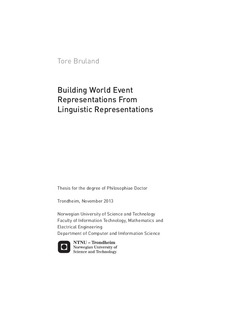| dc.contributor.author | Bruland, Tore | nb_NO |
| dc.date.accessioned | 2014-12-19T13:41:03Z | |
| dc.date.available | 2014-12-19T13:41:03Z | |
| dc.date.created | 2013-11-28 | nb_NO |
| dc.date.issued | 2013 | nb_NO |
| dc.identifier | 668034 | nb_NO |
| dc.identifier.isbn | 978-82-471-4291-2 (printed ver.) | nb_NO |
| dc.identifier.isbn | 978-82-471-4292-9 (electronic ver.) | nb_NO |
| dc.identifier.uri | http://hdl.handle.net/11250/253591 | |
| dc.description.abstract | The goal of the research presented here is to build a natural language processing system for our future natural language applications. We believe that real applications will move our research in Computational Linguistics and Artificial Intelligence forward, and we prefer applications that are attractive to a large number of users. The engine in this system is the wide-coverage grammar Nor- Source, and the research topic is to build a prototype of the natural language processing system. The first part of our research topic is to build a pipeline for our grammar. We present two versions of the pipeline.
The first pipeline has unmapped predicates that contain object and event references at the discourse level. Each object and event has an unique identifier in the discourse, and the pipeline performs a simple pronoun resolution. The second pipeline is a pipeline with predicates mapped to a selected domain, and the discourse contains object and event references at the world domain level. The world references are the result of an interpretation with a logic model or a selection of a previous stored situation. The domain ontology predicates are mapped from the underspecified predicates. Both pipelines have a demonstrator and the specified world pipeline’s domain is the classical Box World from Artificial Intelligence.
The second part of our research topic is to fill the gap between underspecified predicates and domain specific predicates. The meaning representation produced by NorSource is Minimal Recursion Semantics (MRS), and this representation has underspecified quantifier scope and word senses. We have algorithms for solving the underspecified quantifier scope, but we don’t have algorithms for mapping underspecified predicates to domain specific predicates. The starting point is Vendler’s Aktionsart types. The types have a structure and Moen and Steedman showed that a verb argument can coerce the verb from one Aktionsart type to another. Some verbs have culminating states that are not a part of the surface structure of the sentence. Some verbs have additional structure like sub events and causal relations between sub events. Structure of a verb and coercion of Aktionsart types are outside the scope of an MRS, so we want to incorporate some of these notions into our mapping between underspecified and specified predicates. We use a domain ontology and a mapping algorithm. The ontology contains a collection of concepts with a “is-a” hierarchy, “has” relations, and “use” relation. The ontology also contains templates that use the hierarchy and the relations in order to implement constraints on a predicate and its arguments. The ontology contains complex domain objects that generate possible structures, time points, roles and states. We use the Change Location domain to demonstrate how the mapping algorithm works.
We have created a natural language processing system prototype and we have filled the gap between underspecified predicates and domain specific predicates. We can transform our MRSs into expressions in First-Order Logic and reason with them. The tools from the DELPH-IN consortium creates “deep” grammars that offers the meaning representation MRS, and this means that our work can be used by other grammars and languages. | nb_NO |
| dc.language | eng | nb_NO |
| dc.publisher | Norges teknisk-naturvitenskapelige universitet, Fakultet for informasjonsteknologi, matematikk og elektroteknikk, Institutt for datateknikk og informasjonsvitenskap | nb_NO |
| dc.relation.ispartofseries | Doktoravhandlinger ved NTNU, 1503-8181; 2013:97 | nb_NO |
| dc.title | Building World Event Representations From Linguistic Representations | nb_NO |
| dc.type | Doctoral thesis | nb_NO |
| dc.contributor.department | Norges teknisk-naturvitenskapelige universitet, Fakultet for informasjonsteknologi, matematikk og elektroteknikk, Institutt for datateknikk og informasjonsvitenskap | nb_NO |
| dc.description.degree | PhD i informasjonsteknologi | nb_NO |
| dc.description.degree | PhD in Information Technology | en_GB |
